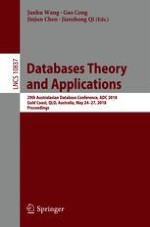2018 | Buch
Databases Theory and Applications
29th Australasian Database Conference, ADC 2018, Gold Coast, QLD, Australia, May 24-27, 2018, Proceedings
herausgegeben von: Prof. Dr. Junhu Wang, Gao Cong, Jinjun Chen, Jianzhong Qi
Verlag: Springer International Publishing
Buchreihe : Lecture Notes in Computer Science
